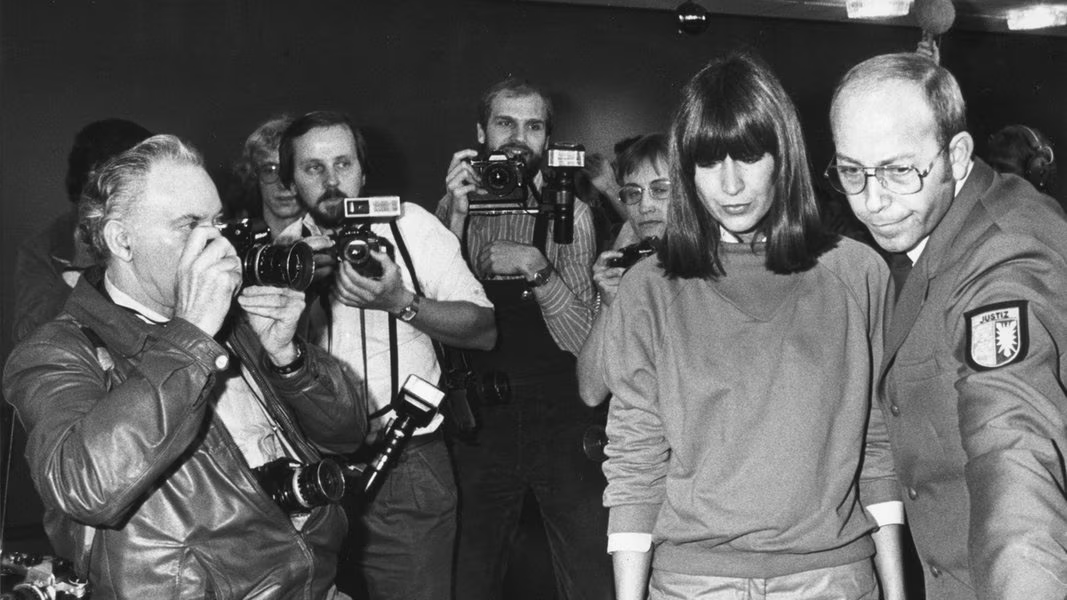NEWS
Marianne Bachmeier: A Mother’s Tragic Vigilante Justice

On March 6, 1981, the German justice system faced a shocking and unforgettable moment. Marianne Bachmeier, a grieving mother whose daughter had been brutally murdered, walked into a courtroom in Lübeck and shot Klaus Grabowski—the man accused of taking her child’s life. The courtroom, once a symbol of law and order, turned into a scene of vigilante retribution. What followed was not just a legal case, but a moral debate that captivated a nation and continues to resonate decades later.
Marianne Bachmeier’s name became etched in the collective memory of Germany, and indeed the world, as people struggled to understand what could drive a mother to kill in a courtroom full of witnesses. Her actions begged complex questions: Was she a criminal or a broken mother? Did she avenge her daughter, or did she undermine justice?
Who Was Marianne Bachmeier?
Born in 1950 in Germany, Marianne had lived a troubled early life. Her upbringing was marked by trauma, including the loss of her father during World War II. She became a mother at a young age and raised her daughter Anna alone. Their bond was reportedly strong, though like any parent-child relationship, it wasn’t perfect. Despite life’s challenges, Marianne did her best to provide Anna with a safe home in Lübeck.
The Tragic Murder of Anna Bachmeier
In 1980, Marianne’s world shattered when her 7-year-old daughter, Anna, failed to return home from school. Panic quickly spread, and a police search began. The community was shaken when Anna’s lifeless body was found—strangled and stuffed into a box by a known pedophile named Klaus Grabowski.
What made the case even more disturbing was Grabowski’s criminal history. He had been convicted of sexually abusing young girls multiple times. After being chemically castrated, he underwent hormone treatment to reverse it—clearly with disturbing consequences.
The killer didn’t act alone either. Grabowski’s girlfriend reportedly urged him to commit the murder to avoid returning to prison, fearing that Anna might report him to the police.
The Trial and the Courtroom Shooting
On the morning of March 6, 1981, Marianne entered the courtroom carrying a small pistol in her handbag. As the trial commenced, and as the man who had murdered her daughter sat before her, something inside her snapped. She pulled the pistol out and fired seven shots at Klaus Grabowski. He died instantly.
The courtroom erupted. Some screamed, others ducked, and a few were stunned into silence. The trial transformed into a crime scene. However, for many who heard about it later, Marianne was not seen as a criminal—but as a symbol of a mother pushed to her limits.
Why Did She Do It?
Marianne later explained that she had been unable to bear the thought of listening to her daughter’s killer defend himself in court. She feared that he might walk away with a lenient sentence, or worse, manipulate the system. Her trust in the legal process had eroded entirely.
While the world debated her morality, her pain was real. And yet, her decision carried immense consequences—not just for her, but for how German society viewed justice.
The Legal Consequences
Marianne Bachmeier was arrested immediately after the shooting. She was charged with murder, but public sentiment played a big role in the courtroom. After a highly publicized trial, the court ruled her guilty of manslaughter and unlawful possession of a firearm. She was sentenced to six years in prison but served just three.
The case remained controversial. Was the legal outcome lenient because of public pressure and empathy? Or was it fair, considering her mental state and the circumstances?
Life After Prison
Following her release in 1985, Marianne attempted to lead a quieter life. She moved abroad, first to Nigeria and later to Sicily, trying to escape the media spotlight. Unfortunately, her peace was short-lived. She was diagnosed with cancer and returned to Germany in the 1990s. On September 17, 1996, Marianne Bachmeier passed away at the age of 46.
She was buried beside her daughter Anna, a gesture that reunited them in death if not in life.
Cultural and Legal Impact of the Case
The Bachmeier case became a landmark in both public discourse and legal circles. Germany, at the time, was deeply divided over vigilantism. For some, Marianne became a martyr—a mother who had the courage to act when the system failed. For others, she represented a dangerous precedent, where personal justice could override the law.
TV specials, books, and documentaries later examined the case from various angles. Each one tried to unpack the layers of grief, rage, and moral complexity embedded in that moment she pulled the trigger.
The Debate Over Vigilante Justice
The Marianne Bachmeier case reignited an age-old debate: Is taking the law into your own hands ever justified?
Many argued that her mental state was deeply affected by trauma and that her act was not premeditated in the traditional sense. Still, critics warned that tolerating such actions could encourage similar behavior in future cases, potentially destabilizing the justice system.
Legal professionals, ethicists, and psychologists have continued to analyze the implications of her act, even decades later.
Psychological Dimensions
What makes the story even more profound is the psychological torment Marianne endured. She didn’t plan to become a killer. She was, above all, a grieving mother who had reached an emotional breaking point. Clinical psychologists reviewing the case later suggested she exhibited signs of acute PTSD and dissociation at the time of the shooting.
The mental health perspective adds another layer of empathy, if not justification.
How Media Shaped the Narrative
Marianne’s story was told through newspapers, magazines, and eventually through documentaries. The media played a significant role in shaping public opinion—portraying her sometimes as a hero, sometimes as a cautionary tale.
Some critics claimed that the sensationalism surrounding the case overshadowed deeper issues like child protection laws, rehabilitation of offenders, and victims’ rights.
Also read: Marinenet: Revolutionizing Marine Corps Training and Education
Conclusion
Marianne Bachmeier’s story remains a poignant example of a mother’s grief manifesting in an act of vigilantism. Her courtroom shooting of Klaus Grabowski continues to evoke discussions about justice, the legal system’s efficacy, and the lengths to which a parent might go to avenge their child’s death.
FAQs
Why did Marianne Bachmeier shoot Klaus Grabowski?
Marianne acted out of grief and rage, unable to accept that her daughter’s killer might escape full justice. She shot him during his trial.
Was her act considered legal?
No, it was not. She was convicted of manslaughter and illegal firearm possession and served three years in prison.
What was the public’s reaction?
Many sympathized with her pain and considered her a mother driven by desperation. Others warned of the dangers of vigilante justice.
Did she regret her actions?
In interviews, she expressed both sorrow and a sense of relief. She struggled with her decision until the end of her life.
What happened after her release?
Marianne moved abroad, but later returned to Germany due to illness. She died of cancer in 1996 at the age of 46.
Where is she buried?
Marianne is buried next to her daughter Anna in Lübeck, Germany.
Is there any film or documentary about her?
Yes, her story has been depicted in multiple documentaries and media pieces exploring themes of justice and maternal love.

-

 EDUCATION3 months ago
EDUCATION3 months agoFree Cover Letter Generator: Build Job-Winning Letters in Minutes
-

 GUIDE3 months ago
GUIDE3 months agoBenefits of Online Personal Training for Fitness Success
-

 BUSINESS2 months ago
BUSINESS2 months agoGrow Your Audience with USA Instagram Followers
-

 TECH2 months ago
TECH2 months agoFreedom Forever Solar Reviews Explain How Conversational Intelligence Turns Customer Interactions into Insights